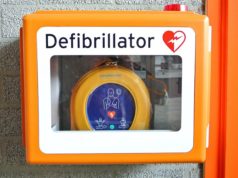 Automated external defibrillators (AEDs) are associated with increased survival of sudden cardiac arrest when installed in schools, yet only 17 out of 50 US states require AED installation in at least some of their schools, according to an analysis published in the Journal of the American College of Cardiology.
Automated external defibrillators (AEDs) are associated with increased survival of sudden cardiac arrest when installed in schools, yet only 17 out of 50 US states require AED installation in at least some of their schools, according to an analysis published in the Journal of the American College of Cardiology.
State requirements for AEDs in schools in the USA vary widely. Researchers used LexisNexis Academic to find current state statutes and regulations on AED requirements in schools across the country.
As of February 2016, 17 states had some legislation requiring AED installation in schools, but the remaining 33 states had no legislation. This is an increase from the nine jurisdictions that required AED installation in 2010. However, in the 17 states, requirements are far from comprehensive:
Of the 17 states requiring AEDs:
- One comprehensively requires them in public grade schools, private schools and colleges
- Four require them in public grade schools and colleges
- Two require them in public and private grade schools
- Nine require them only in public grade schools
- One requires them only in colleges
Only five states offer unequivocal funding to schools for purchasing AEDs. Researchers calculated that nearly 35 million public elementary and secondary students attend school in US states with no legislative requirement for a school AED.
“Installing AEDs in schools should include a plan for implementation in which all staff are trained in the use of the AED, integrated with cardiopulmonary resuscitation training” says Mark Sherrid program director for the hypertrophic cardiomyopathy program and professor of medicine at NYU Langone Medical Center in New York City, USA, and the paper’s lead author. “This review should be used to inform the debate about expanding community-access AEDs into schools.”
A questionnaire study of sudden cardiac arrest in US high schools determined that two in 50 US high schools can expect a sudden cardiac arrest event each year. Several observational studies show an association between AED installation in schools and colleges with increased survival. Collapse to defibrillation time was shorter when administered by bystanders than by emergency medical services (3.3 vs. 12.9 minutes). In schools with AED programs, the survival rates of students with cardiac arrests and a shockable rhythm ranged from 64% to 72%. AEDs in schools may also be deployed for teachers, coaches or sporting event spectators who may suffer cardiac arrest on school grounds. Because of their age these individuals are statistically at higher risk for cardiac arrest; more adults than children may be resuscitated by AEDs in schools and their environs.
Many states, with no requirements for school AEDs, have placed a higher legislative priority for required AEDs in other locations, such as state office buildings, health clubs, gambling facilities, racetracks, and jails. Timely AED availability is important in all population-dense settings, and an AED requirement in schools should be added in these states as part of a policy to expand the reach of public access defibrillation community wide. Researchers conclude that states without such legislation may “look to neighboring states for examples of child and adult lifesaving law.”










